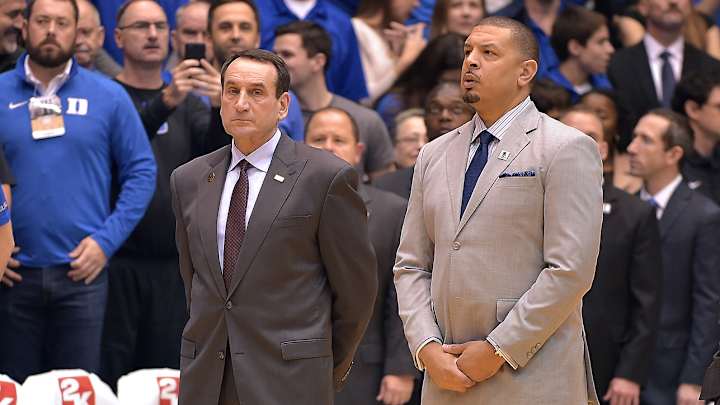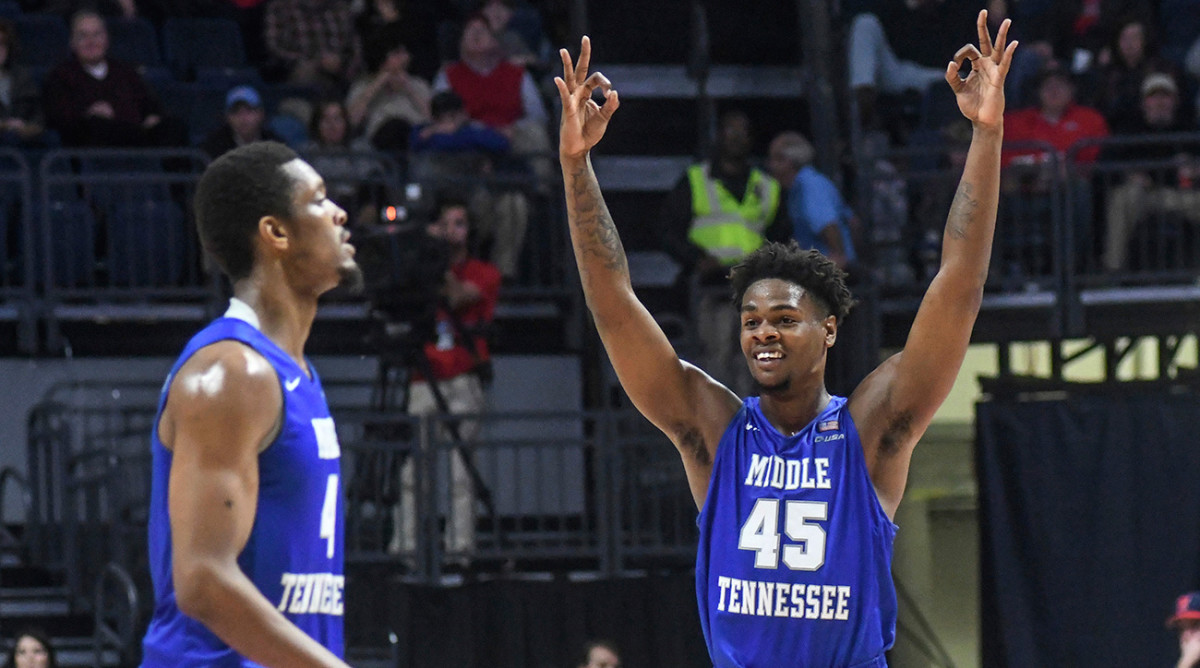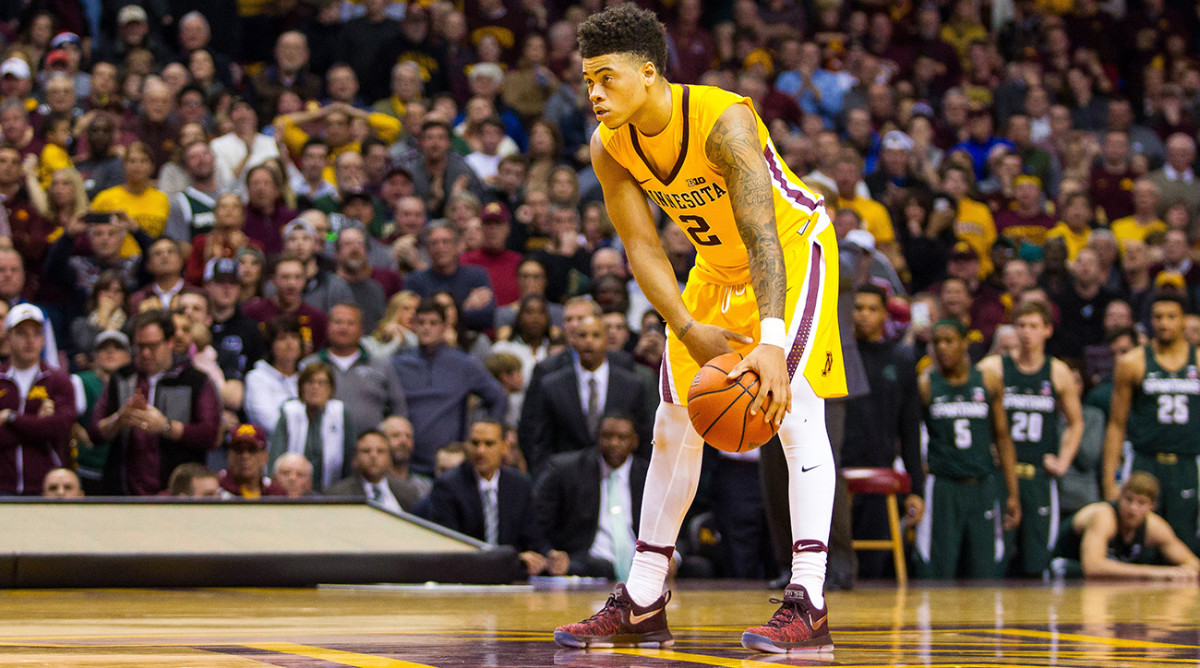Mail: Can Jeff Capel cement his status as Coach K's successor this month?

The first edition of the 2017 Twitterbag has a decidedly blue tinge. That’s because there is one particular fan base already singing the blues. To wit:
With the blowout loss to Virginia Tech and the absence of Coach K for who knows how long, how concerned should Duke be going forward? — Danny Rinehart (@daskins_21)
Think Duke can turn this thing around? — Jeremy Shaheen (@JeremyAShaheen)
Has your outlook for Duke changed due to Coach K health news? Any idea how much longer Allen sits? — Ivan Snyder (@ivansnyder)
Who do you see being Coach K’s replacement when he’s all done? Obviously a former player, but which one? — Dylan Link (@dylanlink123)
I’ll try unpack this bag one blue hanky at a time.
First, Grayson Allen. We still don’t know whether Allen will play for the Blue Devils when they host Georgia Tech on Wednesday night. Frankly, I hope he does. I believe that a one-game suspension is suitable for his transgressions. As bad as his tripping incident was in the Elon game—especially since this was the third time—it did not even warrant his being ejected. He sat out the game at Virginia Tech, after which Mike Krzyzewski announced that he has stripped Allen of his team captaincy. And let’s not forget the very public humiliation Allen suffered as a result of all of this. Bottom line: He did the crime, and he has done the time.
However, we still don’t know the degree to which Krzyzewski is concerned about Allen’s emotional maturity. He may decide Allen should sit out for longer to make sure he has the proper mindset when he does return. The most important thing is that Allen is mentally O.K., and that he never does something like that again.
Coach K's injury is the latest setback in a disjointed Duke season
As for how this team deals with Krzyzewski’s absence, I think things will go considerably better than the last time Krzyzewski had to step away with back problems, in 1995, when he missed the last two-and-a-half months of the season. The problem in that case wasn’t the surgery itself (which happened in October) but rather Krzyzewski’s hard-headed insistence on returning before he was fully recovered. He became so physically exhausted that he was basically dysfunctional. While he was away, Coach K had limited contact with the coaching staff, and his team finished with a 2–14 ACC record.
This time, however, the procedure is not as drastic, and the recovery time won’t be as long. And I have no doubt that Krzyzewski will be a lot smarter about making sure he is fully healthy before he returns to the bench. In the meantime, he will be in regular contact with interim coach Jeff Capel and the rest of the staff. That means he will still be making the final decision as to when Allen can play again.
None of this has changed my long-term outlook about Duke. In the short-term, however, this team will have to navigate some adversity. Besides the injuries and all the tumult, the Blue Devils have not been playing inspired basketball the last two weeks, including their no-show drubbing at Virginia Tech. The good news is there is plenty of time to recover, but they do need to get started.

This leaves us with one of the more intriguing questions in all of this—namely, whether these next few weeks will position Capel as Duke’s heir apparent. After all, Coach K is turning 70 in February. He may have a few years left in him, but it can’t be that many, right? We can safely assume that Krzyzewski will be succeeded by one of his former assistants. There is an older group of guys (Notre Dame coach Mike Brey, UCF’s Johnny Dawkins, and Harvard’s Tommy Amaker) who in another time and place would have been tapped. Dawkins, for example, was in line to get the job the last time Krzyzewski flirted with the NBA in 2004, when he briefly considered an offer to coach the Lakers.
Now, however, it appears the gig would go to either Marquette coach Steve Wojciechowski, Northwestern’s Chris Collins or Capel. My gut tells me that the longer Capel sits at Coach K’s side, the more likely it is that he would get the gig. He checks a lot of boxes. He has been a former head coach (at VCU and Oklahoma, although his five-year stint at Oklahoma ended badly when he was fired in 2011). He has done a stellar job recruiting since he returned to Duke as an assistant that spring. And he has a reputation for being smart, tough and charismatic, the kind of guy who is just as at ease conferring with millionaire CEOs as he is teenage prodigies.
It might be stretching things a tad to call these next few weeks an official audition, but let’s face it, if the Blue Devils perform well while Capel is running the show, it will be a great help to his cause. This season has a long way to go, and Krzyzewski is not giving any indication that he is ready to hang it up soon. But the end of his tenure is going to come, and Capel is well positioned to be the next man up.
Should Kentucky want to add Diallo this late? Seems like it might cause chemistry problems. — Edward Pierce (@ewpierce85)
Edward is referring to Hamidou Diallo, a supremely talented and athletic 6' 6" swingman from New York who was recently cleared by the NCAA to play college basketball in the second semester of this season. He is currently doing a postgraduate year at Putnam (Conn.) Science Academy, which means he will be eligible for the 2017 NBA draft. Diallo has recently taken visits to UConn and Kentucky, and apparently Arizona is also in the mix.
Hoop Thoughts Stock Report: Picking teams to buy, sell and hold
Diallo has about another week to decide what he’s going to do. It is increasingly likely that he will be at a college campus soon, but it is not entirely clear whether he will go there to practice with the team and train in preparation for the draft, or whether he will be on the court in uniform as well. From what I am hearing, I think it is possible he could end up at Kentucky—but if he is, he will probably not play for this year’s team. If Diallo insists that’s what he wants to do, it will be hard for John Calipari to tell him no—but he should do it anyway. Adding a player like this could disrupt the team’s chemistry, and Diallo himself may be so far behind that he’d only have a limited impact anyway. In other words, the potential downside is a lot bigger than the potential upside. That wouldn’t be the case at UConn, which is struggling badly and could use the help.
Also, it’s worth noting that Auburn just added a player, 6' 11" center Austin Wiley, who was a senior in high school but finished in time to join the team mid-semester. This has been going on for years in college football, but the difference is when a football player enrolls in school mid-semester, he is arriving during the off-season. A basketball player arrives just as teams are entering conference play. So we could be entering a new era where we will see multiple teams try to get stronger through mid-season reinforcements. Stay tuned.

Most dangerous mid-majors not named Gonzaga or Wichita State? — Billy Davis (@BUBulldogBill)
My cousin Billy obviously knows how much I love to make lists. Here you go:
1. Middle Tennessee. I’ve been on the Blue Raiders’ bandwagon from the start of the season, and even though I was a little rattled by their loss at home to Georgia State, I still think they are the one mid-major that no one will want to see in the tournament. Besides returning their core players from the group that beat Michigan State in the first round last year, Middle Tennessee also added 6' 8" senior forward Jacorey Williams, a transfer from Arkansas who is averaging 17.4 points and 7.1 rebounds a game.
2. Saint Mary’s. The Gaels are fun to watch because they share the ball and make a lot of shots. They won’t win a lot of games with their defense, and I still wish coach Randy Bennett would challenge his guys with a more rigorous nonconference schedule. But they have one of the nation’s most efficient offensive players in the country in 6' 11" junior forward Jock Landale.
3. UT Arlington. If I’m going to list the Gaels, I’ve got to include UTA, which knocked off Saint Mary’s in Moraga by 14 points. The Mavericks also beat Texas in Austin by 11 points and played Arkansas tough in Bud Walton Arena before falling by four. Their starting lineup features three seniors and two juniors.
4. UNC Wilmington. The Seahawks are 13–2 but couldn’t quite close out their two best opportunities for a marquee win, losing to Middle Tennessee (neutral) and Clemson (road). They have two of the top five scorers in the CAA in 6' 5" sophomore guard C.J. Bryce (18.1 ppg) and 6' 5" senior guard Chris Flemmings (16.8).
5. Rhode Island. I know the Atlantic 10 doesn’t like to think of itself as a mid-major, but there are signs that Danny Hurley’s Rams are starting to round into form. They have won five out of their last six, and on Tuesday night they crushed a pretty good Saint Joseph’s team by 30.
UNC Wilmington looks poised to repeat in CAA and return to NCAAs
Should Iowa State’s struggles this season have been expected? Will they get it together in time to get into the tourney? — Brandon Groepper (@brandongroepper)
I’m not sure how Brandon is defining struggle, but I see a very good team here that is going to return to the Top 25 before long. Iowa State has lost three games, and all were respectable: to Gonzaga by two on a neutral court, to Cincinnati by one point in overtime at home, and at Iowa by 14. They have a heck of a test tonight at Baylor, and while I don’t necessarily expect them to win that game, I think there’s a lot to like about a team that starts five seniors and has arguably the best pure point guard in the country in Monte Morris. And you might be surprised to learn that this is a better defensive team right now than an offensive team. The Cyclones are 17th in Ken Pomeroy’s defensive efficiency rankings, and 54th in offensive efficiency. I’d like to see them be less reliant on making threes and more aggressive in getting to the foul line, but something like that is easily correctible.

What’s Minnesota’s ceiling in the Big Ten? — Mr. Wilson (@mrwils24)
This is a timely question coming off the Golden Gophers’ very impressive win 91–82 overtime at Purdue. Much attention was rightly given to sophomore guard Nate Mason’s sterling 31-point, 11-assist, 6-rebound effort, but I thought the real story of the game was Minnesota’s defense. The Gophers limited one of the nation’s best three-point shooting teams to a 9-for-28 performance at home. As the Boilermakers struggled to score, the Gophers were able to chip away at the seven-point deficit the faced midway through the second half. And Minnesota’s overall quickness basically took 7-foot center Isaac Haas out of the game down the stretch. Matt Painter could only play Haas 19 minutes as a result. He finished with six points and three rebounds.
Nor do I think that win was a fluke. In their previous game, the Gophers controlled things at home against Michigan State but coughed up a late lead and lost by one point. We’ll see over the next few weeks whether they can sustain this, but for the time being, I really like this team’s defense-first identity. The Gophers are ranked 16th in the country in defensive field goal percentage (37.7), they are 14th in three-point defense (28.4) and they’re 15th in defensive efficiency. That looks like an NCAA tournament team to me.
I thought Saturday was the first time Louisville had looked in sync all year. A mirage or an actual stepping stone? — Ed Hall (@mhall985)
From one Pitino to the other, but the story is the same: a team that centers its identity on defense. That was not the case for the first seven weeks for Louisville, but the Cardinals went next level in that pasting of Indiana last Saturday. Defense is going to be extremely important because this is not an overly skilled offensive team. It’s nice that Donovan Mitchel and Deng Adel are shooting the ball well of late, but I’m not buying that for the long term.
I am, however, buying this team’s overall length and athleticism, which should cause nightmares for opposing offenses—and not just in the fullcourt press. A huge key to this has been the emergence of 7-food junior center Anas Mahmoud as an elite rim protector. Mahmoud only plays about 20 minutes per game, but he is averaging 2.5 blocks, and as a team Louisville ranks sixth in D-I in blocks with 6.6 per game. Louisville is also first nationally in defensive efficiency. So to answer Ed’s question, I think this team took a big, big step with that Indiana game, not just because of the margin but the reason the Cardinals won it.
